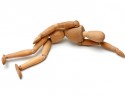
Subsequent human studies revealed that the mutation in the hypocretin-related gene is extremely rare, and only one case of early-onset narcolepsy to date was identified as having a mutation in the preprohypocretin gene. Hypocretin neurons are exclusively located in the lateral hypothalmic area, but project to most brain areas. The hypocretin/orexin system is a recently discovered hypothalamic neuropeptidic system. Mutation of one of the two hypocretin/orexin receptors and knockout of the hypocretin/orexin gene (preprohypocretin) causes narcolepsy in dogs and mice, respectively. Studies in these animals (familial canine narcolepsy in narcoleptic Dobermans and gene-knockout mice) led to the discovery of the etiology of narcolepsy in animals. The identification of cataplexy in these animals led to the discovery of narcolepsy in these animal species. This finding is consistent with the data collected in human narcolepsy and validates the use of this canine model for the screening of stimulant compounds.Cataplexy is also a hallmark symptom of narcolepsy in animals, such as dogs and mice. amphetamine) of stimulants to reduce their level of sleepiness to that of control dogs. Results of polysomnographic recordings also demonstrate that narcoleptic dogs slept significantly more during the daytime than control dogs and required very high doses (10 mg/kg i.v. These results suggest that the pharmacological property of modafinil is distinct from amphetamine.

In contrast, the results of cataplexy testing demonstrate that amphetamine (2.5-160 micrograms/kg i.v.), but not modafinil (0.125-8.0 mg/kg i.v.) significantly suppresses canine cataplexy. Results indicate that both modafinil (5 and 10 mg/kg body weight i.v.) and amphetamine (100 and 200 micrograms/kg i.v.) increase wakefulness and reduce slow-wave sleep in control and narcoleptic dogs.

N2 - The effects of modafinil and amphetamine on daytime sleep (polysomnographic recordings) and cataplexy (the food-elicited cataplexy test) were compared using the narcoleptic canine model. T1 - Comparative effects of modafinil and amphetamine on daytime sleepiness and cataplexy of narcoleptic dogs. This finding is consistent with the data collected in human narcolepsy and validates the use of this canine model for the screening of stimulant compounds.


The effects of modafinil and amphetamine on daytime sleep (polysomnographic recordings) and cataplexy (the food-elicited cataplexy test) were compared using the narcoleptic canine model.


 0 kommentar(er)
0 kommentar(er)
